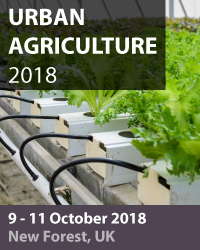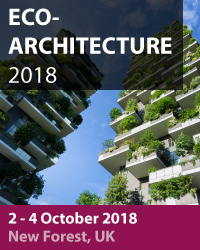1st International Conference on Urban Agriculture and City Sustainability
9 - 11 October 2018
New Forest, UK
Overview

The first International Conference on Urban Agriculture and City Sustainability took place in the New Forest, UK. The Conference was organised by Wessex Institute, UK represented by Dr Stavros Syngellakis and the Polytechnic University of Valencia, Spain represented by Professor Jose Luis Miralles i Garcia.
The aim of the Conference was to review and discuss ways in which urban agriculture can contribute to achieving sustainable cities. As urban populations continue to increase, it is essential to consider ways of reducing their impact in terms of the use of natural resources, waste production and climate change.
Opening of the Conference
The conference was opened by Dr Stavros Syngellakis, who welcomed the delegates to the conference then mentioned the main objective of WIT, which is the dissemination of knowledge with particular emphasis on science and engineering. Another way in which this is achieved is through the publication of papers from conferences and Journals, via its publishing arm, WIT Press.Stavros ended his presentation of WIT’s activities and achievements with a tribute to the founder of the Wessex Institute, the late Prof Carlos A Brebbia.
Professor Jose Luis Miralles i Garcia also welcomed the delegates and briefly described the motivation, scope and objectives of the meeting.
The Chief Academic Officer of WIT, Professor Santiago Hernandez, was introduced to the conference delegates on the second morning and stayed for the coffee break.
Invited Presentations
Jose Luis Miralles i Garcia gave a keynote address entitled “New policies for the management of peri-urban agricultural spaces: The case of L’Horta de València (Spain)”.Another keynote address entitled “Continuous Productive Urban Landscapes (CPULs) and the CPUL city” was given by Andre Viljoen, University of Brighton, United Kingdom.
In addition, there was an invited lecture entitled “Users’ perceptions and attitudes towards edible campus” by Ting-I Lee, National Chiayi University, Taiwan.
All presentations generated considerable interest among delegates as evidenced by the number of questions and the lively discussions that followed. There were also numerous occasions for the delegates to hold informal discussions during the coffee and lunch breaks.
ISAC Meeting
The meeting of the International Scientific Advisory Committee (ISAC) of the Conference took place during one of the lunch breaks. The focus was on the discussion of which new topics should be included in the Call for Papers, aiming for the continuous evolution of the conference. Other topics were the organisation of the Committee and the location of the 2020 conference.Special Events
On Wednesday 10th October, UA conference delegates took a coach trip to visit several sites of interest in the City of Bristol which is a thriving centre for Urban Agriculture in the South West of England. Their first stop was at Grow Bristol, located in a refurbished shipping container in the urban regeneration area of the city. The company is run by the enthusiastic team of Founder and Managing Director, Dermot O’Regan and Operations Director, Oscar Davidson, and is an indoor vertical farm that utilises the technologies of hydroponics and controlled environment agriculture. Grow Bristol started as a pilot project to provide nutrient rich leafy greens without the use of pesticides and now harvest and sell their products, using an electric trike to deliver, to over 60 customers across the city. The delegates visited the scheme and saw inside the growing environment, and tasted some of the products which were delicious, including pea shoots, coriander, radish and chives. Harvesting can take place 50 times a year and of course, the harvests are unaffected by the varying weather conditions as all growing is indoors. They are always trying to improve their carbon footprint and are currently trialling a range of sustainable growing mats which they use instead of soil.The delegates then walked for ten minutes and found themselves at another urban site, made from a converted railway arch unit, at the research facility belonging to "LettUs Grow". They specialise in Aeroponics, growing their test crops with roots not in soil but instead in a nutrient rich mist. They are researching into engineering solutions for farms of the future and patenting their equipment to supply the optimal conditions for growth. They have linked up with several universities and this means they can provide opportunities for PhD students to work alongside them to obtain answers to key questions in the field. They are supported by a number of funding schemes, and they recently were one of only five finalists winning €100,000 in the prestigious international competition in sustainable entrepreneurship, The Green Challenge 2018. Co-founder and Managing Director, Charlie Guy and Indoor Farm Manager, Dan showed us around the controlled growing environment, with state of the art equipment developed by the team, and we were able to taste test the herbs.
The delegates then met with horticulturalist, educator and urban gardener, Sara Venn, who took us on a one hour walk of the Incredible Edible Bristol Urban Food Trail, showing us how the urban environment has been transformed by volunteers around the city under Sara's guidance, so that all people can have access to vegetables and fruit in unexpected locations. The visitors saw how the previously derelict flower beds at the Bristol City council buildings at 100 Temple Street, are now growing Jerusalem and globe artichokes, nasturtiums, carrots and cabbages for all to help themselves! In addition, Sara has transformed what was an overgrown area at The Edible Park at the Quaker’s Burial Ground, and made it much more inviting by simply changing the planting around the entrance. It is now still welcoming for those who used it before as a safe haven, but is also a centre for families to come and educate themselves about the benefits of growing their own vegetables and fruit. There were also fruit trees aplenty at the St Mary Redcliffe Fruit Garden, which is at the front of one of the most stunning Gothic churches in the city.
Conference Dinner
Finally, the delegates walked the ten minutes in the unexpectedly warm sunshine to Wapping Wharf where the conference dinner was to take place in another of the recently regenerated parts of the city, at a converted shipping container at Tare Restaurant. Matt Hampshire, Chef and Owner, and his team source all their ingredients as locally as possible and in fact they are one of Grow Bristol's customers. The delegates enjoyed a three course meal, beautifully presented and served from the restaurant’s open kitchen and accompanied by a choice of red or white wine. They then took tea and coffee on the terrace with a view of the sunset over the city. It was a very special location and ambience, a truly beautiful evening.Closing of the Conference
The conference was closed by Stavros and Jose Luis, who thanked the delegates for attending and hoped that they would consider attending other WIT conferences. It was a highly successful meeting in terms of the quality of the presentations and the extent of discussions that took place during the conference.Conference Publication
Some of the papers presented at this conference will appear in Vol. 217 of the WIT Transactions on Ecology and the Environment (ISSN 1743-3541).A number of papers have been selected instead for publication in the International Journal of Design & Nature and Ecodynamics. This Journal acts as a channel of communication for researchers from around the world working on a variety of studies involving nature and its significance to modern scientific thought and design.
All papers presented at the meeting are available Open Access in the eLibrary of the Wessex Institute (https://www.witpress.com/elibrary), from where they can be freely downloaded by any interested parties.
Related Conferences
Water Resources Management 2019, 7 - 9 May 2019River Basin Management 2019, 8 - 10 May 2019
ECOSUD 2019, 19 – 21 June 2019
Air Pollution 2019, 26 – 28 June 2019
Sustainable City 2019, 1 - 3 Oct 2019
Water & Society 2019, 2 - 4 October 2019
